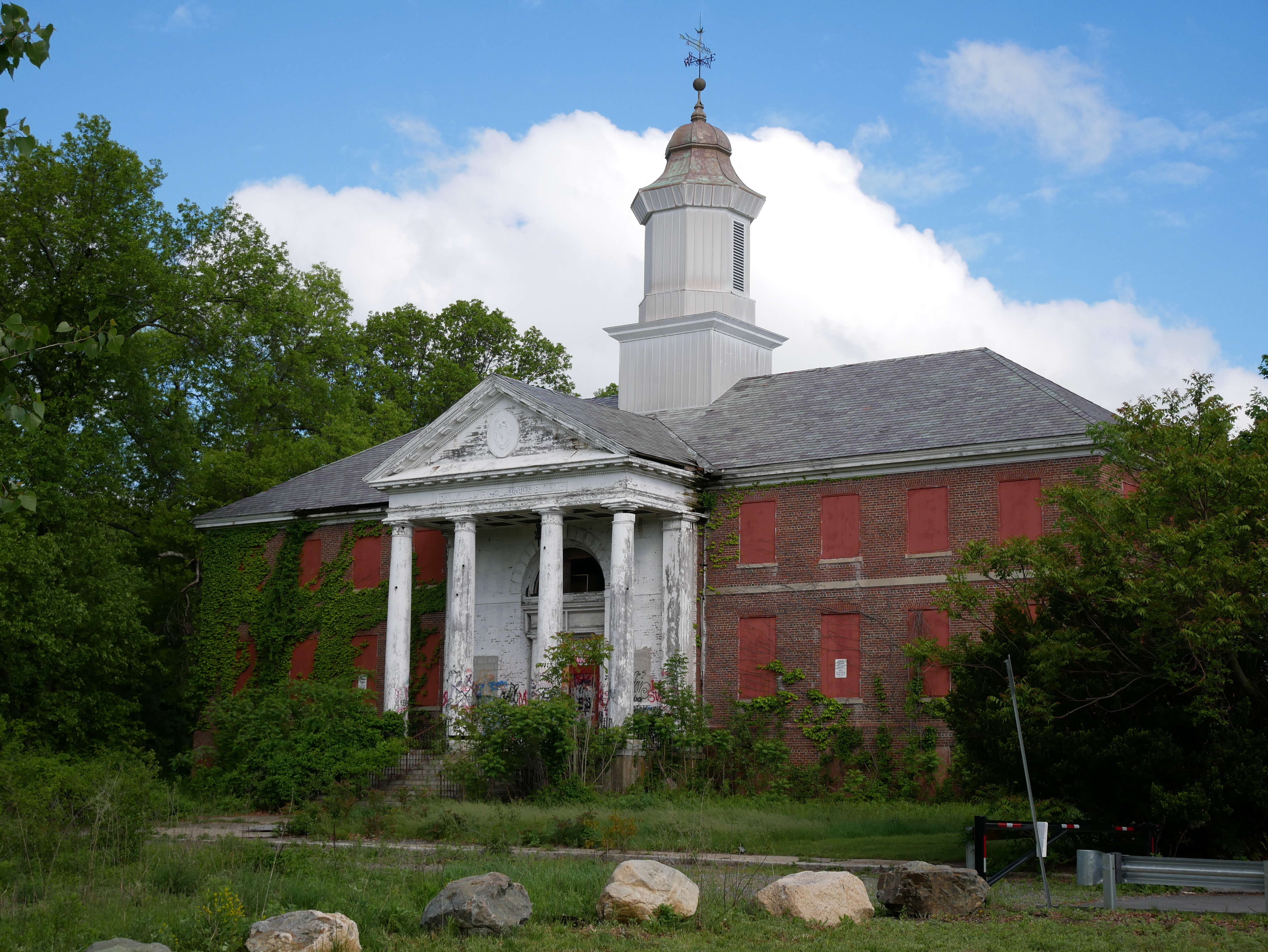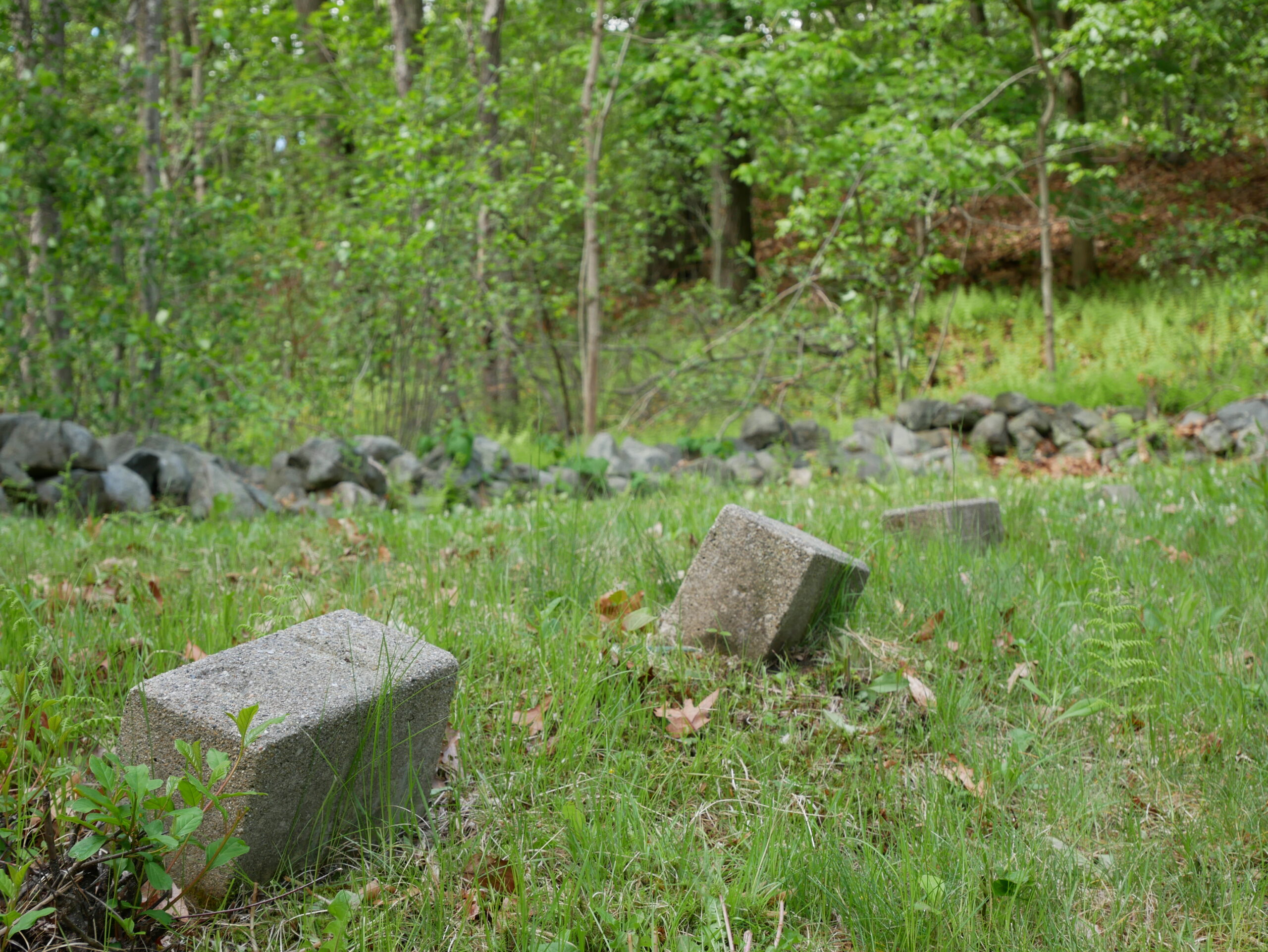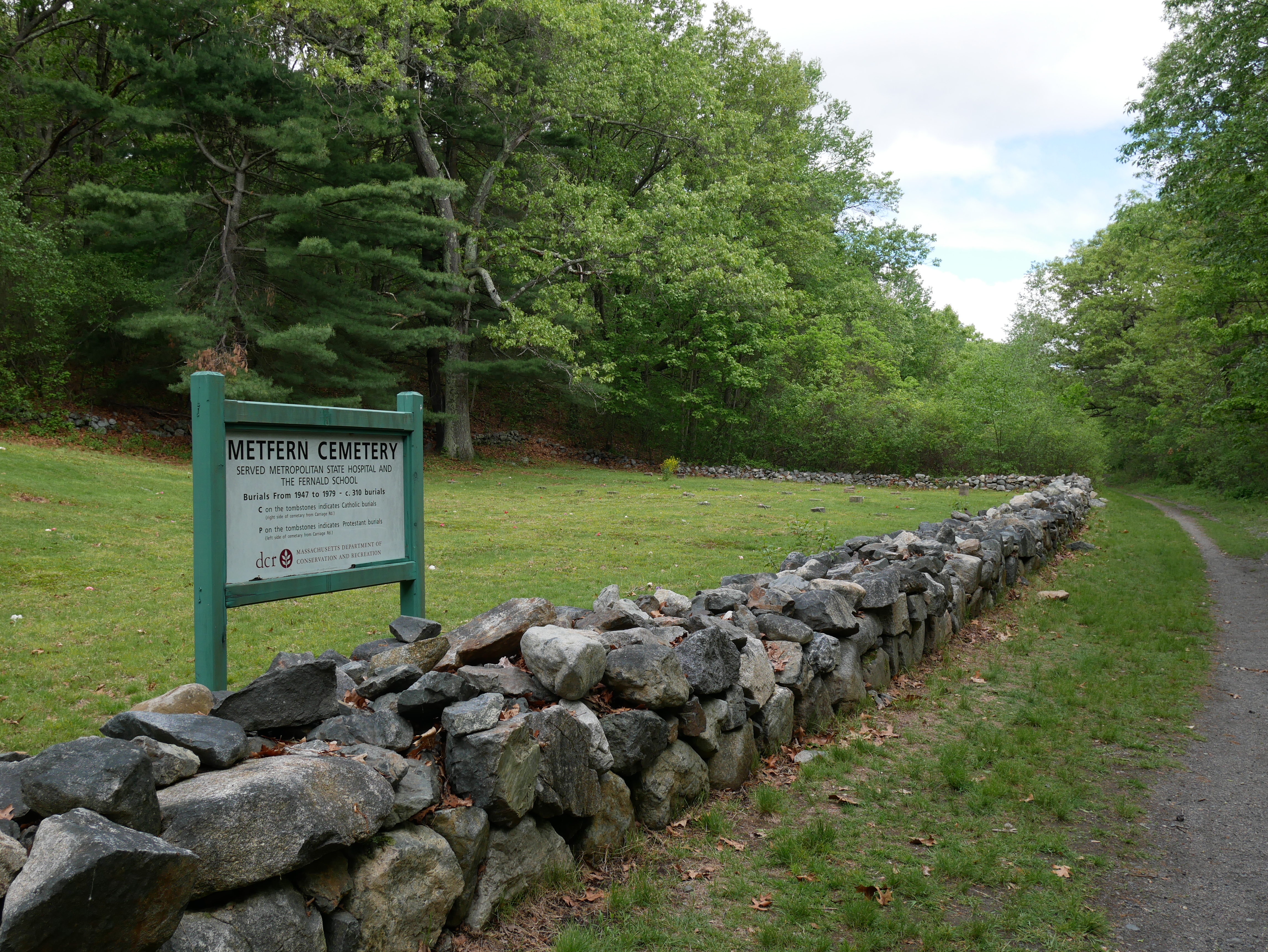A plot. A boneyard. A potter’s field. A necropolis. A golgatha.
I stumbled upon it one steamy day in the first summer of COVID, while my car was in the shop for repairs. Rather than hunker in a socially-distanced corner of the dealership waiting room while mechanics wrestled with a failed catalytic converter and timing belt, I decided to spend several hours wandering the drowsy streets of Waltham, a suburb just west of Boston. The sidewalks were deserted because of the heat, or the virus shutdown, or both, and I passed empty schoolyards, shuttered storefronts, dormant office parks, a winding succession of ranch and colonial homes; some rising pristine beyond manicured lawns, some peeling and overgrown, signaling despair.
On a whim, I cut through a stretch of wooded parkland, following a dirt track over a low ridge and down into a shady glen. Around a bend, a peculiar stretch of shabby lawn came into view: long and narrow, like a landing strip hidden in the woods, bordered by a low stone wall. Each end of the clearing was studded with a grid of low granite blocks in orderly rows, and each weathered block was marked with a letter and a number crudely carved into its top face. A simple billboard mounted behind the stone wall proclaimed the clearing to be the Metfern Cemetery, where residents of the nearby Metropolitan State Hospital and the Fernald School were buried between 1947 and 1979. The sign noted that the letter “C” carved in the stones at the righthand end of the lot indicated Catholic burials, while the “P” markers at opposite end were for Protestant internments. That was it: no names, no circumstances, just a mute line of sentinel trees beyond the stone wall, and the dirt track winding its way back to meet up with Trapelo Road and the branching subdivision tracts inhabited by the living, sweltering residents of Waltham.
A scar on the earth. A minor state secret. A whiff of municipal shame. A murmuration of stones.
I vaguely remembered something about a reference to a Fernald School from a long-ago medical ethics class, a cringeworthy case of residential schoolboys fed radioactive oatmeal without their knowledge. I picked up my car and headed home to learn more about this secluded site and the institutions behind it. An internet search revealed that the Fernald School was originally named the Experimental School for Teaching and Training Idiotic Children when founded in 1848, and served as the primary state residential facility for well over a century, housing and training cognitively-challenged children on a campus of grim, red-brick institutional buildings. Many residents lived out their entire lives in spartan, 36-bed dormitories, and many reports of physical and sexual abuse have accumulated over the years. The state finally closed the campus in 2014, dispersing the final thirteen residents, one who had lived there for sixty-five years, into local community service programs, and selling the campus back to the City of Waltham, where it remains unused, a crumbling, brick-faced ghost town, propped up by its inclusion on the National Register of Historic Places.
The infamous radioactive oatmeal study that I had recalled was jointly sponsored by Harvard, MIT, and the Quaker Oats Company in the 1950’s; boys were offered extra portions and trips to Red Sox games for participating in a “Science Club” where their nutritional uptake was assessed by tracking isotopes they ingested. Neither the boys nor their parents were told of the nature of the study, or given adequate opportunity to provide informed consent for their participation. It took decades for the details of the project to come to light, and a class-action suit against MIT and Quaker finally resulted in a $1.85 million settlement for the surviving victims in 1998.
The Metropolitan State Hospital was Massachusetts’ state-of-the-art public hospital for the mentally ill when it opened in 1930. At its peak in the 1950’s, the hospital housed nearly two thousand patients, but Massachusetts joined up in the national trend toward deinstitutionalization of psychiatric patients, and in subsequent decades the Metropolitan’s prestige and funding were gradually squeezed dry. The hospital closed in 1992, after an interminable bureaucratic struggle to arrange alternative housing and services for the last of the life-long residents being served there; its outbuildings were converted into condos and offices, and its central administration building, a hulking, Doric-columned massif in the Colonial Revival style, was also abandoned to the National Register of Historic Places, to be overrun with vines and graffiti.
Drilling deeper into the Metfern Cemetery story, I discovered a recent online project led by a Harvard Kennedy School faculty member, Alex Green, who enlisted a class of high school seniors to comb through state and town registries for birth, death, and immigration records, using these paper records along with online genealogy databases to build brief biographies of the 296 men and women they determined had been buried in the Waltham woods. The scraps they pieced together were threadbare: a birthplace, the names of parents or a spouse; sometimes an occupation, usually chronic medical and psychiatric conditions, and almost always a cause of death. Some of the residents in both institutions were forced to do hard menial labor, housework and groundskeeping, while others were too debilitated to work. The students built a public website where the people now can linger over sketches of how these forgotten residents lived, and died:
C-13: died of pneumonia 4/21/1949, age 83. C-59: diagnosed as having “idiocy”, died 5/2/1958, age 80. C-34: born with hydrocephalus, died 6/24/1954, age 8 months. P-15: Born in Latvia, died of breast cancer 9/14/1949, age 63. C-116: fell out of wheelchair, lacerating his brain 8/12/1966, age 22. P-50: died of a heart attack while mowing the hospital lawn 5/16/1955, age 51.
One odd detail in the narrative of C-160 [died of pneumonia 12/12/1975, age 65] grabbed my attention: “at some point she had undergone a salpingectomy, in which the fallopian tubes are removed, and it does not appear that she had children.” In such a scant rendering of a life, why do we learn that she was sterilized? And why go to the trouble to sterilize a childless woman, living in a secured institution? I learned the Fernald School was named after its third Superintendent, Walter Fernald, who had been widely lauded as an innovative early twentieth-century educator of “mentally retarded children.” Fernald was also an ardent advocate for eugenics, the pseudoscience that posited one could improve the human race be carefully selecting who did and didn’t pass along their genes by having children. American eugenicists feared that the country’s potential talent and intelligence was at risk of being insidiously undermined by defective members of its lower classes. Involuntary sterilizations of women and men deemed hopeless alcoholics, epileptics, criminally insane, feebleminded, and sexually promiscuous were common in state-run institutions around the country through the mid-twentieth century, and these procedures were practiced regularly at both the Fernald School and the Metropolitan State Hospital.
C-160’s story cuts to my core because of the legacy of my grandfather, Clarence Gamble, who was an heir to an industrial fortune, a physician, a pioneer in the field of world population control, and a eugenicist. He lived in a white mansion on a hill south of Boston, and although he mainly focused his work in the developing world, he also promoted and funded sterilization programs in southern U.S. states, targeting mostly the rural poor, mostly people of color. He touted sterilization as a humane, inexpensive method for communities to control social costs by preventing new generations of hapless feebleminded people from becoming expensive wards of the state, noting the procedures were barely invasive, just a snipping of tubes, and that “nothing needed to be taken out of the body.” He often referred to his work as “The Great Cause,” and I’m sure he approved of the efforts at Fernald and the Metropolitan in his own backyard, to stop people from passing on bad genes. I cringe when I consider his cause now, imagining a link in a long chain of elite initiatives, framed as medical progress, but built on the exploitation and suppression of the most marginalized humans among us:
J. Marion Sims, gynecological surgical experiments on enslaved women (1845). The Virginia State Colony for the Epileptics and Feebleminded (1910). Caswell Training School, North Carolina (1911). Buck v. Bell, Supreme Court ruling on sterilization (1927). The Tuskegee Syphilis Study (1932). Oral contraceptive clinical trials, Puerto Rico (1956). Irwin County Detention Center, Georgia, coerced sterilizations of detained migrant women (2020).
I’m a nurse practitioner, and I’ve worked for twenty years with homeless people in Boston, accompanying folks through terrible crises and small victories in their difficult lives. I’m struck while reading the brief life sketches in the Metfern Cemetery project, that if these patients and residents were alive today, I might be caring for them in an outpatient clinic, helping to manage their blood pressure or HIV meds, accompanying them through relapses on booze and opiates, treating wounds after an assault or being hit by a car. I honestly don’t know if they would be better off now, released from a lifetime of institutionalization in grim dormitories, instead living day-to-day in squalid shelters, or on the streets, catching a few hours’ sleep on a subway bench or in an ATM booth. I do know this: with all the troubles they endure, they all have complex, valuable lives, and they each have stories to tell. In our clinics, when we learn someone has died, we share anecdotes about them, their quirks and passions, and we remember their names. And we hold an annual service to intone the names of those who died in the previous year in a litany, to hold them up in the light. Alex Green notes that there are countless internment plots and potter’s fields like Metfern tucked into shady forgotten corners around the country. How consistently we ignore the most vulnerable in our midst, the living and the dead.
At least the numbered stones on this plot have reclaimed their names now:
C-13: John Edwin Higgins. C-59: Hannah “Anna” Berry. C-34: Diane Coleman. P-15: Mary Kivet. C-116: Vincent Strudas. P-50: Paul Werner. And C-160: Geraldine Etsell.
 Images: Provided by Alex Green and used with permission. For more about the MetFern Cemetery Project, please visit: http://www.metferncemetery.org/metfern.
Images: Provided by Alex Green and used with permission. For more about the MetFern Cemetery Project, please visit: http://www.metferncemetery.org/metfern.
- Pause - September 27, 2024
- A Murmuration of Stones - September 10, 2021



